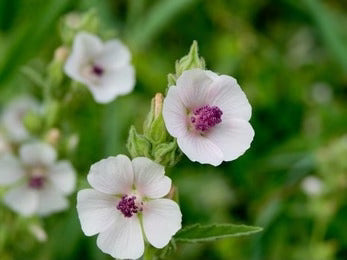The Greek term that means "to heal" is the source of the generic name Althaea. This herb is therefore used to promote the body's ability to mend itself. The perennial herb Althaea officinalis, also known as marshmallow, is a member of the Malvaceae family. This herb grows wild in Punjab, Kashmir, and Himachal Pradesh and is native to Eastern Europe. The parts of the plant that are useful for making remedies are the roots, flowers, seeds, and leaves. In addition to its medical applications, marshmallow is a popular ornamental plant and ingredient in a variety of oils, paints, glues, and other products. Particularly in Europe, roots are used as a seasoning in a variety of foods, and even the blossoms are used in salads. This herb's flowers are similar to those of A. rosea Cav. In traditional medicine, this herb is frequently utilized for medicinal purposes. Unfortunately, there isn't much proof supporting this herb's use in different medical systems.
Vernacular Names
- Hindi - Gulkhero
- English - Marshmallow, Hollyhock
- Pharsi - Khatmi
- Unani - Khatmi, Gulkheru
- Sidha/Tamil - Shemai-tutti
Properties
This herb is not listed in our Ayurvedic texts under specific medications. However, Althea officinalis is referenced in Bhava Prakasha Nighantu under the heading "Parishishta Varga."
|
Particular |
Hindi / Sanskrit |
English |
|
Rasa (Taste) |
Madhura |
Sweet |
|
Guna (Quality) |
Snighdha, Picchila, Guru |
Unctuous, Slimy, Heavy |
|
Virya (Potency) |
Sheet |
Cold |
|
Vipaka (Post-Digestive Taste) |
Madhura |
Sweet |
Effect on Dosha
It Reduces Vata and Pitta dosha in our body.
Pharmacological Actions
- Demulcent - The gastrointestinal tract's inner mucosal lining can be covered by this plant thanks to its demulcent properties. Thus, it helps in enteritis.
- Antitussive - Because of its expectorant quality, it aids in the body's removal of toxins and excess mucus. As a result, it helps with bronchitis, asthma, cough, etc.
- Antilithic - Helps in the body's breakdown of calculi, or stones. It is beneficial in calculus.
- Diuretic - This herb is excellent for kidney stones, burning micturition, gastritis, and other conditions because it helps the body expel toxins through the urine. It is the preferred medication for dysuria since it makes urination easier.
- Anti-inflammatory - It is used to combat infections and inflammation because of this characteristic.
- Laxative - It is utilized to remove toxins from the body since it also has a slight laxative effect on humans.
- Immune-modulator - This herb strengthens immunity since it immediately affects our immune system.
- Anti-microbial - Because marshmallow possesses this quality, it can treat every kind of infection in the body.
Chemical Composition
The marshmallow plant includes the following: tannins, phenolic acids, polysaccharides, asparagines, starch, pectin, flavonoids (quercetin, kaempferol), and sucrose. Various phytochemicals such as lauric acid, β-sitosterol, stigmasterol, lanosterol, altheacalamene, etc. are also present in it.
Therapeutic Uses
- It is helpful for peptic and stomach ulcers. It lowers inflammation and infection in the body due to its calming and relaxing qualities.
- Its antitussive qualities help to alleviate cough and mucosal pharynx. Because it removes excess mucosa from the respiratory system and oral cavity, it is frequently used to treat coughs.
- Chronic Gastritis: It helps to control the amount of hydrochloric acid in our stomach, which relieves burning, bloating, and discomfort. In addition, it lowers the pH levels of all bodily fluids, including blood, urine, and gastric secretions. It also lines the inside of the stomach, preventing gastric discomfort, due to its demulcent quality.
- It is applied topically to bruises, varicose veins, and skin ulcers.
- Moreover, because of its antibacterial qualities, it is helpful in treating burns, wounds, ulcers, and cuts.
- This plant is used to lower blood sugar and cholesterol levels in the body.
- All things considered, this herb is helpful in treating respiratory, urinary, and gastrointestinal issues.
- Overall this herb is beneficial to treat Gastrointestinal, Urinary, and Respiratory tract disorders.
Mode of Use
Marshmallows can be used internally as well as externally. It can be used as a paste, syrup, or decoction.
- Paste - The paste made from the roots and leaves can be applied topically to treat skin conditions, bruising, and ulcers. It reduces swelling and promotes healing. Insect bites and muscle sprains can also be treated with the paste.
- Decoction - We can utilize the root decoctions produced for gargling as a means of treating Pharyngitis and oral ulcers.
- Because the plant possesses the "Vranaropaka" quality, which promotes early healing, even the decoction can be used to wash wounds and ulcers.
- The leaves can be infused and taken internally to treat cystitis and uncomfortable urination.
- This plant's twigs can be used as a toothbrush to reduce dental sensitivity and pain.
- Poultice - The majority of the time, seeds and leaves cover the irritation.
- Herbal Tea - Drinking tea made from the dried roots of the marshmallow plant can help soothe sore throats since it lessens discomfort and pain. In addition, this herbal tea is loaded with nutrients and antioxidants that are good for your body.
Parts Used
Roots, flowers, and leaves
Dosage
5 to 7 grams.
Caution
Please see a doctor before using "Marshmallow" as medicine, as this herb might have harmful effects on the body in certain situations.

